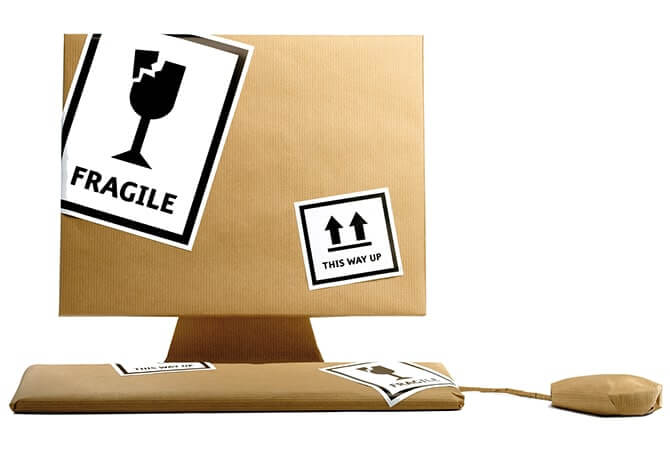Computer equipment is costly and difficult to replace, so when moving these things, we make the following recommendations:
- Backup all data and software files very carefully into the cloud or onto a disk, DVD’s, or
CD’s . Make a thorough checklist of all software and data files to be saved (don’t forget to save your favorites file) from the computer. Be sure you have all of your original installation softwareCD’s in case you need to reinstall for any reason. You might want to clear your computer and reinstall everything anyway, once you’re settled into your new residence. Get a case or a special box just for all of these things and hideit in the trunk of your car. But don’t leave them there for long if the environment is extremely hot or cold. On a long-distance move, bring them into the motel each night. - Use the original boxes and styrofoam from the purchase of your computer equipment, your monitor and/or your printer. If the styrofoam is missing still, use the original box but wrap each unit in pads, blankets, towels or bunched-up packer’s paper (not
newspaper because the print will get all over the casings and will probably not clean off) before placing them into the box. If you don’t have the original boxes, then go and purchase some good heavy-duty boxes big enough for each major component (don’t forget to leave enough room for its padding). Remember pack the desktop unit, the monitor and the printer each into their ownseperate boxed. - Pack the monitor with extra padding and cardboard on the glass face and stand it up in the box with plenty of padding underneath, surrounding its base to keep it upright. Mark as – Glass – Fragile! – on the side of the box which is right in front of the screen. This will signal the movers as to where the glass is inside of the box.
- Disassembled circuit cards, RAM, disc drives, etc. should be sealed in non-static plastic bags and only be packed in paper. Bubble wrap and foam wrap can generate a static discharge which can ruin these components! Smaller components such as keyboards, mouses, speakers, cameras, scanners, wiring, etc. can all be packed together in a box or two but you should carefully wrap each of these things with the above-described packing materials before putting them into the boxes.
- Mark all computer component boxes as Fragile! This Side Up! – but do not mark them as – Computer Components! You don’t want thieves to spot them on your truck and grab them in an unguarded moment or after seeing these things being moved into your new residence, they become their signal to set you up for a burglary later. Instead, if you must label them, then code mark them as say – Old Junk – or something like that.
- When loading these things onto the truck, do not put other things on top of them, especially heavy stuff. These are expensive, delicate items that need to be treated with special care and good common sense. You might even want to lock these things in your car. Don’t let anyone who is helping on the move, who may be at all careless, handle these boxes
. I f you do load them into your car instead of the truck, be sure to keep the car locked at all times. Then hide them in the trunk or under a blanket or some other way because if you leave your car unattended, thieves could break in and steal them. It’ s best to load computer stuff last and unload it first into the new residence in order to avoid theft and/or temperature extremes which can damage electronics. On long-distance moves, when there are extreme temperatures involved, carry them inside the car (not the trunk) and into the motel room overnight.


